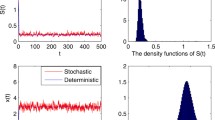Abstract
The stochastic dynamics of a chemostat with three trophic levels, substrate-bacterium-worm, is analyzed. It is assumed that the worm population is perturbed by environmental stochastic noise causing extinction in finite time. A diffusion model of the process is formulated. With singular perturbation methods applied to the corresponding Fokker-Planck equation an estimate of the expected extinction time is derived. This chemostat can be seen as an experimental sewage-treatment system in which the worm population facilitates the reduction of remaining sludge
Similar content being viewed by others
References
Crow J.F., Kimura M. (1970). An Introduction to Population Genetics Theory. Harper and Row, New York, 591 pp.
Roughgarden J. (1979). Theory of Population Genetics and Evolutionary Ecology: An Introduction. Macmillan, New York, 634 pp.
Hanski I. (1999). Metapopulation Ecology. Oxford University Press, Oxford, 313 pp.
Grasman J., van Herwaarden O.A. (1999). Asymptotic Methods for the Fokker-Planck equation and the Exit Problem in Applications. Springer-Verlag, Heidelberg, 220 pp.
Freidlin M.I., Wentzell A.D. (1984). Random Perturbations of Dynamical Systems. Springer, New York, 326 pp.
Gardiner C.W. (1983). Handbook of Stochastic Methods for Physics, Chemistry and the Natural Sciences. Springer-Verlag, Heidelberg, 442 pp.
Schuss Z. (1980). Theory and Applications of Stochastic differential Equations. Wiley, New York, 321 pp.
Ratsak C.H. (1994). Grazer Induced Sludge Reduction in Wastewater Treatment. PhD thesis, Free University, Amsterdam 193 pp.
Kooi B.W., Poggiale J.C., Auger P. (1998). Aggregation methods in food chains. Math. Computer Model. 27:109–120
Roozen H. (1990). Analysis of the Exit Problem for Randomly Perturbed Dynamical Systems in Applications. PhD thesis Wageningen University, Wageningen, 156 pp.
Grasman J. (1996). The expected extinction time of a population within a system of interacting biological populations. Bull. Math. Biol. 58:555–568
Grasman J. (1998). Stochastic epidemics: the expected duration of the endemic period in higher dimensional models. Math. Biosci. 152:13–27
van Herwaarden O.A. (1997). Stochastic epidemics: the probability of extinction of an infectious disease at the end of a major outbreak. J. Math. Biol. 35:793–813
Author information
Authors and Affiliations
Corresponding author
Rights and permissions
About this article
Cite this article
Grasman, J., Gee, M.D. & Herwaarden, O.A.V. Breakdown of a Chemostat Exposed to Stochastic Noise. J Eng Math 53, 291–300 (2005). https://doi.org/10.1007/s10665-005-9004-3
Received:
Accepted:
Published:
Issue Date:
DOI: https://doi.org/10.1007/s10665-005-9004-3




